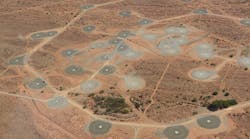When it is completed in 2020, the Square Kilometer Array (SKA) will be the world’s largest and most sensitive telescope. Until that massive 350-engineer project is finished, however, the MeerKAT telescope array will continue to hold that title for the southern hemisphere. The MeerKAT array, which will make up 25% of the total SKA, is made up of 64 antennas that recently became operational. The radio-telescope array is designed to locate RF signals from the farthest reaches of the universe.
With the design of the antennas completed, Stratosat and General Dynamics SATCOM will install the MeerKAT array over the next three years. Located in South Africa’s Karoo region, the antennas were specifically designed to include an “indexer.” It allows scientist to easily change the frequency of one or more antennas during any scientific experiment. The ability to make these changes without disrupting the entire array’s performance is a major milestone in the advancement of radio telescopes.
The antennas utilize both L-band (0.9 to 1.67 GHz) and UHF-band (0.58 to 1.015 GHz) receivers, which are mounted on the indexer. In addition, each 43-metric-ton MeerKAT antenna includes an 8.5-m-tall pedestal containing the antenna control systems. The pedestal supports a 13.5-m main reflector with a boom-arm, which holds a smaller reflector and the indexer mechanism. Radio signals from the antenna will be transmitted to a supercomputer, creating a visual map of the object or region being observed. The data received by a single antenna in one day will reportedly generate enough raw data to fill 14 million 64-GB devices.
The low-noise amplifiers (LNAs) chosen for the receivers were developed by the National Research Council of Canada (NRC). They were specifically designed to be at least 5% more sensitive than typical LNAs to increase the MeerKAT’s overall sensitivity. According to Dr. Jasper Horrell, General Manager of Science Computing and Innovation for SKA SA, "MeerKAT's configuration—the way the antennas are placed on the ground—was determined by the science to be performed with the instrument. Having dishes close together provides sensitivity for imaging large, extended radio structures in the sky. Having dishes further apart provides for high resolution.”
Due to this feature, 48 of the 64 dishes will be close together in an area that is about 1 km in diameter. The rest of the antennas will extend to 4 km from the core. The largest space between antennas will be about 8 km.
Each of the 64 receptors are connected by 170 km of underground fiber-optic cable, which allows them to operate as a single, highly sensitive astronomical instrument. The data is sent to an array-specific building, the Karoo Array Processor Building (KAPB). It houses all of the racks of digital data-processing systems and the necessary electrical power equipment. The KAPB is located 5 m below ground level in order to protect the MeerKAT from any RF interference generated by the electronics in the data center.

